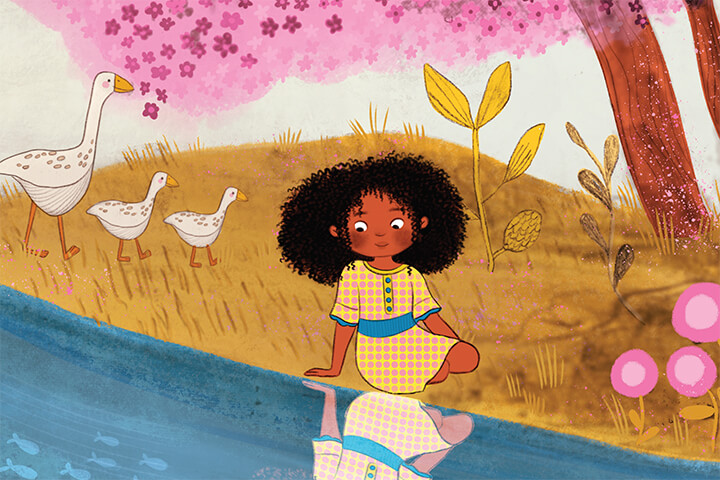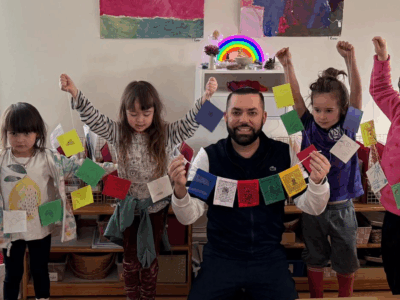How Do We Support Our Children’s Happiness?

About This Resource
Details
How Do We Support Our Children’s Happiness?
Supporting Our Children’s Full Range of Emotions
By Wendy O’Leary, author of Breathing Makes It Better
WHEN IT COMES TO WISHES FOR OUR CHILDREN, “MAY YOU BE HAPPY” TOPS THE LIST.
BUT WHAT DOES THAT MEAN AND WHAT CAN WE DO TO SUPPORT OUR CHILDREN’S HAPPINESS?
If you have children you know the feeling; the deep desire to FIX things that don’t go their way—that urge to manage and get ahead of their possible disappointments and frustrations and to see them “happy.”
I remember clearly sitting in a parents group when my youngest was in elementary school and participating in a discussion about what we wanted most for our children. Being happy was at the top of everyone’s list, and yet our ideas of what this meant and how to “make” it happen seemed unclear at best and more than a bit out of sync with the reality of how the world works. Parents at this workshop wanted their kids to make the team, get the part in the play, get into the right college, be successful in school, have good friends, be popular, and the list goes on. Basically happiness was defined as the “oh so practical” wish for them to never feel let down or disappointed and for everything in their lives to be perfect! You see the problem with this version of happiness, right?
So, what does it mean anyway, to be happy?
And how do we help our children find this illusive happiness, when, let’s face it, many of us have struggled with this concept ourselves?
The idea, so prevalent in our society, that happiness is an end goal—a place to get to or a thing to attain and not instead a way to simply walk through life—is the first obstacle.
In my work with adults, one of the most common places they get stuck is worrying about their children. There is this desire to have our children reach that place where everything will go smoothly and stay that way . . . always. I confess I have gotten stuck there a few times (or more) myself.
The attempts to make everything go smoothly for our children and to have things go their way as a path to happiness, though often well intentioned, has some not so useful consequences. Though we may try to micromanage for “the benefit” of our children, we aren’t teaching them some of the basic truths of life and how to work with them.
The most obvious of these truths is that sometimes things are hard, sometimes things don’t go our way, sometimes we are disappointed, AND there are ways to work with it. There is, for those of us familiar with the four noble truths, dukkha: unsatisfactoriness, unpleasantness, or “suffering,” as it is often called.
Our capacity to support our children’s happiness is in fact directly related to our ability to help them clearly see and be with what is. The ability to stand our ground and support them in learning to do the same is essential to their well being and ours. As the famous quote by Jon Kabat-Zinn says, “You can’t stop the waves, but you can learn how to surf.” Our job is to teach our children to clearly see the waves and to give them surfing lessons. And, of course, to be there lovingly when a wave or two catches them by surprise.
So how can we model being with what is to support our children in learning this crucial truth in life? How do we teach them to surf?
When your child is struggling, here are some suggestions to manage their emotions:
1. Check in with yourself. You need to be able to be with it first before you are able to skillfully support your child.
2. Cultivate some self-compassion and remember that everyone, even YOUR child, will experience difficulties in life. Saying to yourself something along the lines of, “This is hard. I know that my child, like all children, will have struggles, and I am here for myself through this process” can be really supportive of staying with the difficulties.
3. Acknowledge and accept their feelings to help them do the same! Help them to name it. Naming feelings is a powerful way to step out from inside them and supports the capacity to work with big emotions.
4. Use the “and.” For example: “I know this is hard and . . .” or, “I know you are disappointed and . . .” This is a wonderful way to both validate your child’s feelings and to encourage them to do the same, supporting a kind acceptance that they are hurting.
5. Remind them that sometimes things are hard or don’t go their way or are disappointing . . . and (remember to use and, not but) they can handle it. With deep kindness and compassion, reassure them that you know this is hard and you are there for them, but resist the urge to fix, advise, or do an end run around the problem. This supports their capacity to be with what is with kindness and curiosity, and cultivates and increases the window of tolerance to manage difficult situations and emotions.
6. Then give them some strategies to calm their nervous system. Here are a few of the myriad of calming and focusing techniques that could be beneficial.
Belly Breathing—When breathing in, the belly expands slightly, and when breathing out, it contracts.
Mindful Breathing (Plus)—Simply noticing the breath and feeling it move in the body. I like to add visuals and words when I work with young people. For example: on the in breath, I am a lake, and on the out breath, I am calm. This technique, often taught by Thich Nhat Hanh, can be adapted to use any visual and taps into the power of imagination.
Teddy Bear Breath—This is a great practice for little ones. Have them lie down with a teddy or stuffed animal on their belly, and when they breathe in it goes up and out it goes down, as if they are rocking it to sleep.
Four Square Breathing—This is a great tool for older children. Breathe in for a count of four. Hold for a count of four. Breathe out for a count of four. Hold for a count of four. Do several rounds and then return to normal breathing.
If the emotions are really powerful it is often helpful, after cultivating the awareness and acceptance of the feelings, to then redirect attention to something that helps to support a shift in mindset. Some examples include listening to music, some physical activity, spending time with a friend, or going outside in nature.
Teaching children that the full range of emotions is not something to be avoided and is consistent with happiness is a powerful message. Giving them tools to be with emotions and not inside and swept up by them or avoiding and denying them is a gift for a lifetime.
Wendy O’Leary, M.Ed., educator, and author, has been teaching mindfulness and strategies for emotional awareness and regulation to children and those who care for them for over 15 years. Breathing Makes it Better, co-authored by Dr. Christopher Willard, is Wendy’s book for children. Connect with Wendy at www.wendyoleary.com.
See more:
- The Breathing Makes It Better Guide for Teachers and Caregivers
- A short practice and reflection from Wendy O’Leary on emotion, imagination, and the power of connecting with our bodies.
- Middle Way Education’s review of Breathing Makes It Better.
- Wendy O’Leary guides children in making Happiness Soup!
- In this video, Wendy O’Leary shows children how to relate to feelings of anxiety and shares a breathing exercise to help them feel calmer.

